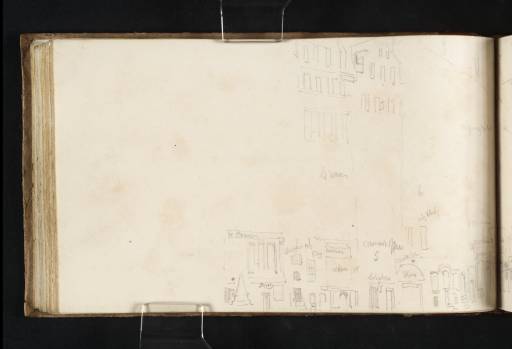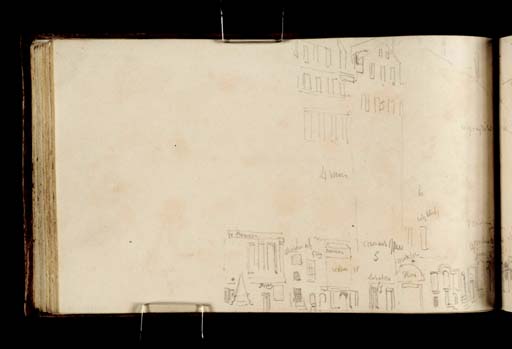Joseph Mallord William Turner St Giles's Cathedral, High Street; Looking West 1818
Image 1 of 2
Joseph Mallord William Turner,
St Giles's Cathedral, High Street; Looking West
1818
Joseph Mallord William Turner 1775–1851
Folio 39 Verso:
St Giles’s Cathedral, High Street; Looking West 1818
D13648
Turner Bequest CLXVII 37a
Turner Bequest CLXVII 37a
Pencil on white wove paper, 112 x 186 mm
Inscribed in pencil by Turner: Upper right ‘grey ship’; upper centre ‘5’; centre ‘4 sash’, centre right ‘6’ | ‘city [?]chambers’; inscriptions above the shops left to right: ?‘Mr Brandon’, ‘D[....]’, ‘Grey’, ?‘Duncan’, ‘[?]council office’; middle row left to right: ‘windows’, ‘w’, ‘5’, ‘max[...]’; bottom row above the doors: ‘Dorry’, ?‘Lubartons’, ?‘Slum’; bottom right top to bottom: ‘J [?]Smithson’, ?‘Armstrong’, ‘[...]’
Inscribed in pencil by Turner: Upper right ‘grey ship’; upper centre ‘5’; centre ‘4 sash’, centre right ‘6’ | ‘city [?]chambers’; inscriptions above the shops left to right: ?‘Mr Brandon’, ‘D[....]’, ‘Grey’, ?‘Duncan’, ‘[?]council office’; middle row left to right: ‘windows’, ‘w’, ‘5’, ‘max[...]’; bottom row above the doors: ‘Dorry’, ?‘Lubartons’, ?‘Slum’; bottom right top to bottom: ‘J [?]Smithson’, ?‘Armstrong’, ‘[...]’
Accepted by the nation as part of the Turner Bequest 1856
References
1909
A.J. Finberg, A Complete Inventory of the Drawings of the Turner Bequest, London 1909, vol.I, p.486, CLXVII 37a, as ‘St. Giles’s Cathedral, High Street; looking west.’.
The drawing on the present page is a rather awkward continuation of a view looking west along the Edinburgh High Street and Lawnmarket on folio 40 (D13649; CLXVII 38). The view is taken from a spot just east of St Giles’s Cathedral – seen on the left of folio 40 – and looks towards Edinburgh Castle. Having begun to sketch the view on folio 40 Turner evidently decided to continue it eastward on the present page, but with insufficient room at the bottom of the page he has had to skew the perspective in order to include the bottom of the buildings, making the picture as a whole rather awkward looking.
The artist’s aim, however, was not to create a successful picture in itself, but to record as much detail as possible of Edinburgh’s High Street, presumably for his Provincial Antiquities design: Edinburgh High Street, circa 1818 (Yale Center for British Art);1 see folios 67 verso–68 (D13701–D13702; CLXVII 64a–65). Hence there is a mixture of detail and economy in the sketch depending on what is being depicted, and inscriptions are used extensively. On the present page, therefore, the roofs and top story of the row of tall, narrow buildings on the south side of the High Street have been drawn in some detail with additional inscriptions to indicate the number of windows: ‘5’ on one building, ‘6’ on another, and ‘4 sash’ windows on a third. There is even more detail at the ground floor of the buildings where shop-fronts, doorways and signs are recorded and descriptions are made. In the middle, however, Turner has saved time by not drawing rows of identical windows, leaving blank space.
There are many shop and establishments in a very narrow space (made smaller by running out of room on the page), and Turner has made numerous inscriptions to record the names of the shops or their proprietors for future reference. While his scrawls are in many case indecipherable to us, the approach served its purpose as Turner was able to paint minute shop signs in Edinburgh High Street and Heriot’s Hospital, Edinburgh, circa 1819 (National Gallery of Scotland).2 One of the inscriptions may refer to the nearby ‘City Chambers’ (home to the City Council), and another to the ‘council office’, while others (mainly illegible) are clearly proprietors names, and there are more references to ‘windows’ and possibly ‘W[ynds]’ (alleys).
For more sketches of Edinburgh High Street see folio 67 verso.
There is some light foxing across the page.
Thomas Ardill
March 2008
How to cite
Thomas Ardill, ‘St Giles’s Cathedral, High Street; Looking West 1818 by Joseph Mallord William Turner’, catalogue entry, March 2008, in David Blayney Brown (ed.), J.M.W. Turner: Sketchbooks, Drawings and Watercolours, Tate Research Publication, December 2012, https://www


